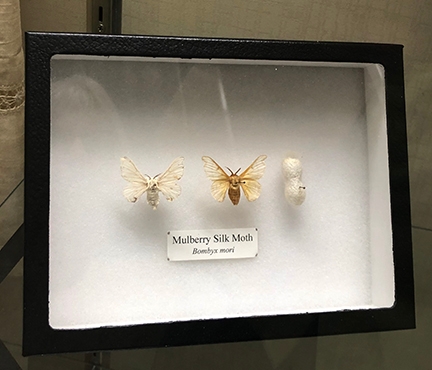
That's what it will be like when folks flock to the Bohart Museum of Entomology on Saturday night, Aug. 3 for its annual Moth Night. It's free and family friendly--and it's all in keeping with National Moth Week: Exploring Nighttime Nature, July 20-28.
The Bohart Museum's highly anticipated Moth Night will take place from 8 to 11 p.m. Visitors will first gather inside the insect museum, located in Room 1124 of the Academic Surge Building, 455 Crocker Lane, to see moth specimens and talk to the scientists; participate in a family craft activity; and view the silkworm moth display in the hallway.
The free family craft activity will involve creating silk moth cocoon necklaces. "Kids will be able to color and string white cocoons and make necklaces or bracelets with them," said Bohart associate Emma Cluff.
Cluff is also creating the hallway display of silkworm moths, showcasing tasar, tussah, eri and mulberry silk. For example, mulberry silk production (Bombyx mori) originated in China at least 5000 years ago, Cluff points out. "These domesticated moths have been selectively bred for so long that they are now dependent on humans for reproduction and survival. Illustrating the mulberry silk display is a tablecloth created in the early 1900s in China. Made entirely from silk, the tablecloth was spun, woven and embroidered by hand."
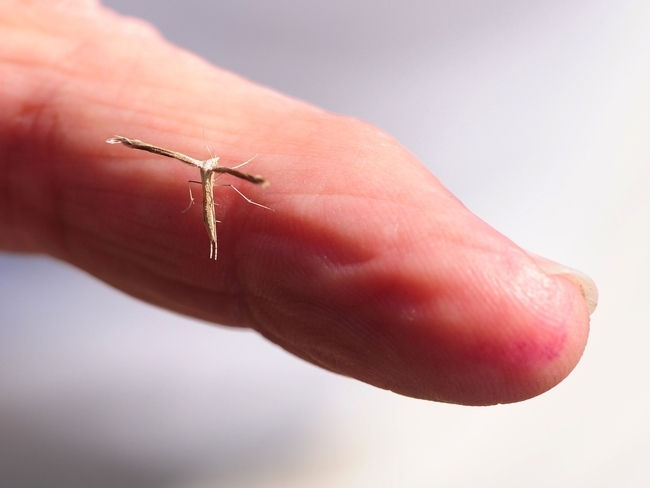
Several scientists will be on hand to discuss moths and answer questions. They include senior museum scientist Steve Heydon of the Bohart Museum; Jeff Smith, curator of the the moth and butterfly specimens; and Bohart associates "Moth Man" John DeBenedictis and Greg Kareofelas.
Last year more than 140 spectators attended Moth Night. The first insects to show up were the scarab beetles or "June bugs" (referring to certain species of scarabs). Beetle expert Fran Keller, assistant professor at Folsom Lake College who received her doctorate in entomology from UC Davis, identified the first scarab beetle to arrive as a Polyphylla sp. or lined June beetle.
Bohart associate and "Moth Man" John De Benedictis listed the species sighted at Moth Night by family. Among them:
- NOCTUIDAE: Spodoptera exigua (Beet Armyworm Moth), Proxenus sp. (probably P. mindara)
- GEOMETRIDAE: Prochoerodes truxaliata
- PYRALIDAE: Ehestiodes gilvescentella
- TORTRICIDAE: Cydia latiferreana (Filbertworm Moth), Grapholita prunivora (Lesser Appleworm Moth)
- GELECHIIDAE: Leucogniella sp. (probably L. distincta)
- TINEDAE: Oinophila v-flava
- ACROLOPHIDAE: Amydria sp., probably Pseudopsalta confusella.)
DeBenedictis said a young girl collected the Prochoerodes truxaliata, a moth that feeds on coyote bush as a caterpillar.
Some facts about moths, from the National Moth Week website:
- Moths are among the most diverse and successful organisms on earth.
- Scientists estimate there are 150,000 to more than 500,000 moth species.
- Their colors and patterns are either dazzling or so cryptic that they define camouflage. Shapes and sizes span the gamut from as small as a pinhead to as large as an adult's hand.
- Most moths are nocturnal--others fly like butterflies during the day.
- Finding moths can be as simple as leaving a porch light on and checking it after dark.
The Bohart Museum, directed by Lynn Kimsey, UC Davis professor of entomology, and founded by Richard M. Bohart (1913-2007), houses a global collection of nearly eight million specimens. It is also the home of the seventh largest insect collection in North America, and the California Insect Survey, a storehouse of the insect biodiversity. It maintains a live "petting zoo," featuring Madagascar hissing cockroaches, walking sticks, tarantulas, and praying mantids. The museum's gift shop, open year around, includes T-shirts, sweatshirts, books, jewelry, posters, insect-collecting equipment and insect-themed candy.
The Bohart Museum's regular hours have changed for the summer season. As of July 3, the insect museum is hosting 30-minute tours starting at 2:30 and 3:30 pm. No reservations are required and all ages are welcome. Admission is free, but donations are always welcomed. The Bohart is open to walk-in visitors Monday through Thursday from 1 to 5 p.m. It is closed from 9 a.m. to noon to walk-in visits (the insect museum conducts many tours and outreach programs during those times).
More information on the Bohart Museum is available on the website or by contacting (530) 752-0493 or email bmuseum@ucdavis.edu.
Attached Images:
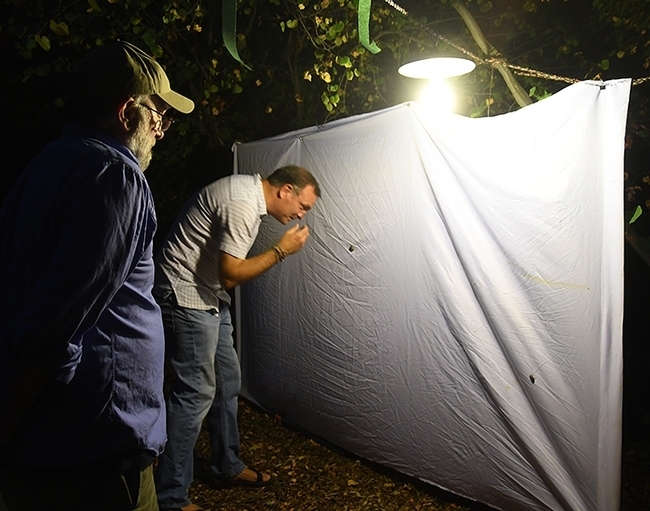
"Moth Man" John DeBenedictus (left) shows Professor Jason Bond the insects on the sheet in the Bohart Museum's blacklighting display last year. Bond is the Evert and Marion Schlinger Endowed Chair in Insect Systematics, UC Davis Department of Entomology and Nematology. (Photo by Kathy Keatley Garvey)
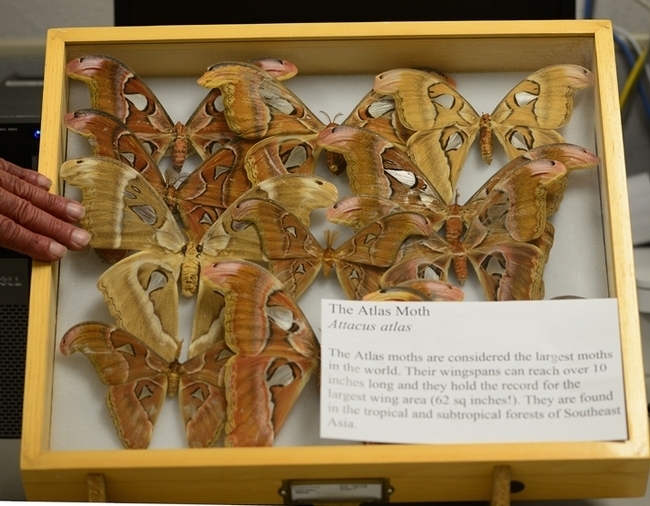
These Atlas moths (Attacus atlas), found in the rain forests of Asia, will be displayed at the Bohart Museum's Moth Night. The moth's wingspan can measure 10 to 11 inches. (Photo by Kathy Keatley Garvey)
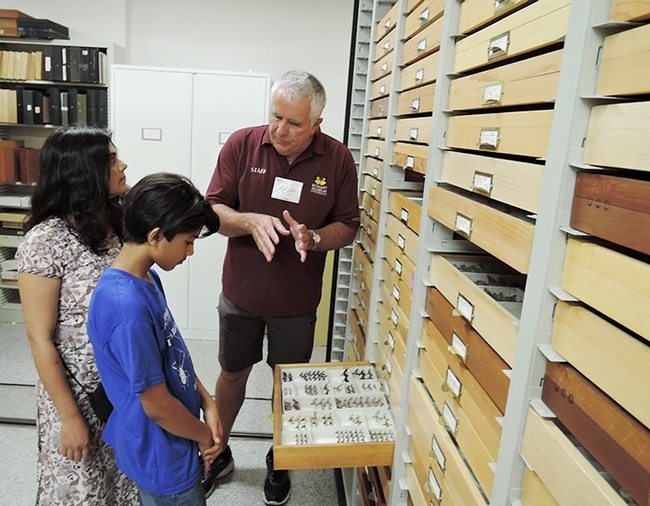
Entomologist Jeff Smith, who curates the Lepitopdera collection at the Bohart, shows visitors part some of the moths. (Photo by Kathy Keatley Garvey)
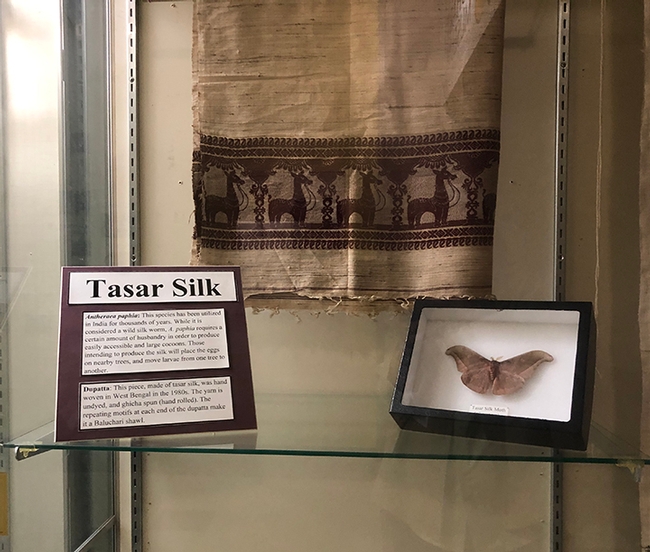
This tasar silk display will be among the silk displays featured at the Bohart Museum of Entomology. It is the work of Bohart associate Emma Cluff. (Photo by Kathy Keatley Garvey)